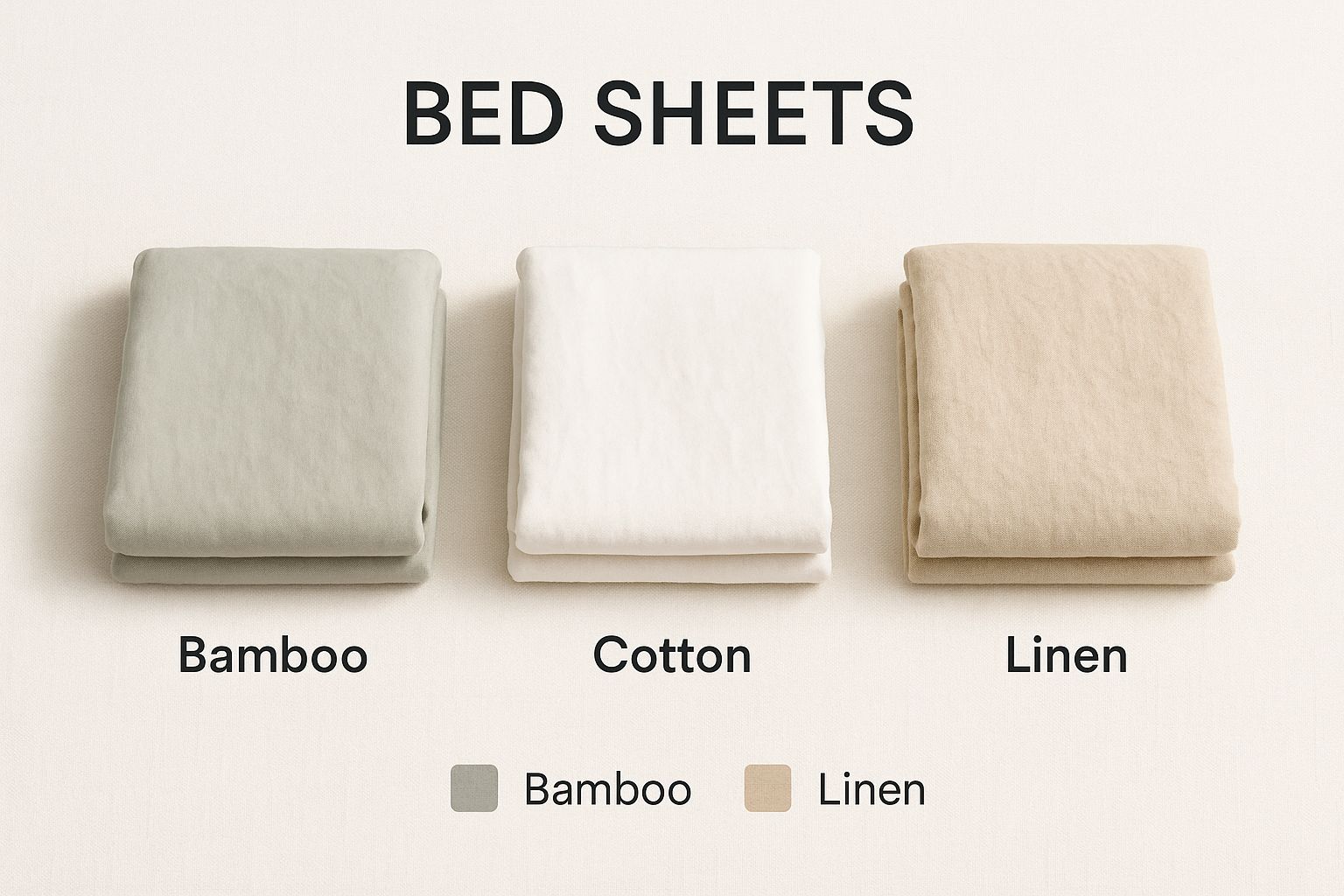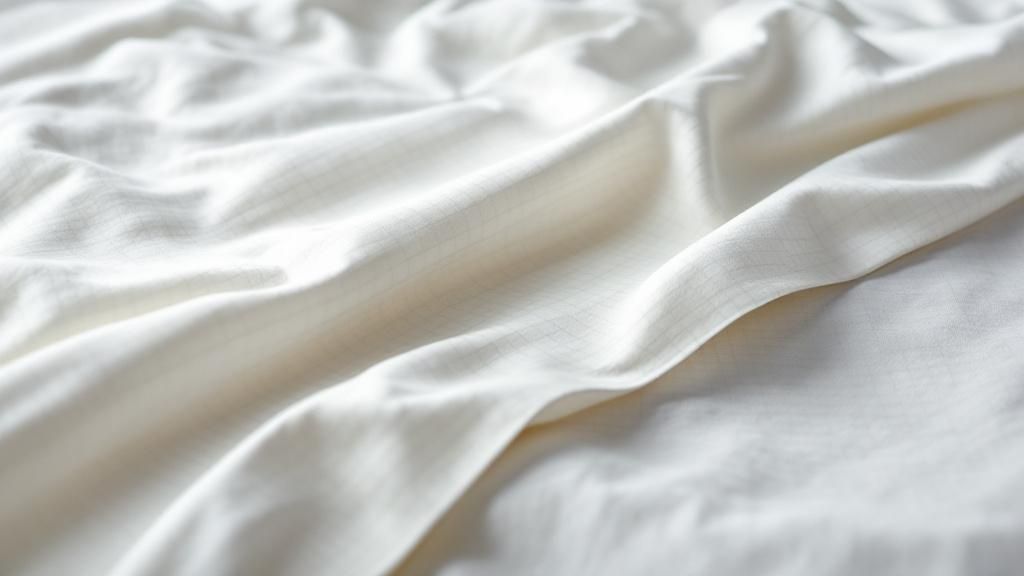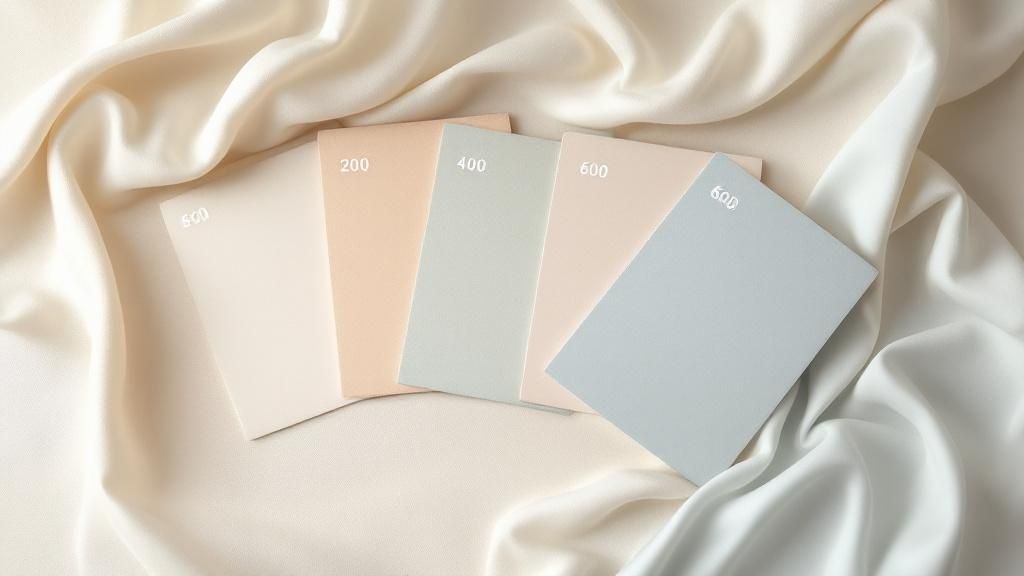If you're a hot sleeper, you know the struggle all too well. Kicking off the covers, flipping your pillow to the cool side, and waking up in a sweat—it's a frustrating cycle. The good news? The solution often comes down to one simple change: your sheets.
The best sheets for staying cool are made from fabrics that breathe and wick away moisture. Think materials like bamboo, Tencel, linen, and percale cotton. These aren't just buzzwords; they're your ticket to a more comfortable night because they actively work to pull heat and sweat away from your body.
Your Guide to Finally Sleeping Cool
Let’s be honest, finding the right bedding can feel overwhelming. But if you’re constantly battling the heat at night, it’s one of the most effective changes you can make. The real secret isn't a high thread count, but the inherent properties of the fabric itself.
This guide will walk you through the options that actually work. We'll get into why some materials are brilliant at keeping you cool while others just trap heat. And you're definitely not the only one looking for relief.
The demand for better sleep is huge. The U.S. bedsheet market was valued at around USD 7.75 billion and is expected to climb to USD 11.55 billion by 2032. This surge is all about people like us wanting textiles that help manage temperature for a better night's rest.
Understanding Your Options at a Glance
Sometimes, seeing is believing. The different textures and weaves of cooling sheets can tell you a lot about how they'll feel.

While they're all great choices, each one brings something unique to the bed. Linen offers that classic, airy crispness, while bamboo provides an almost silky softness. In fact, many people find that bamboo delivers the perfect blend of luxurious feel and serious cooling power. If that piques your interest, we have a whole article dedicated to why bamboo sheets are a cool and eco-friendly choice for hot sleepers.
To make things even clearer, here’s a quick breakdown of the top materials.
Quick Guide to Cooling Sheet Materials
I've put together this simple table to help you compare the best fabric choices at a glance. It covers what makes each material cool, how it feels, and how well it holds up over time.
| Material | Key Cooling Property | Feel & Texture | Durability |
|---|---|---|---|
| Bamboo | Highly breathable & moisture-wicking | Silky, smooth, and soft | Very durable with proper care |
| Linen | Exceptional airflow, very porous | Crisp, airy, softens over time | Extremely durable, gets stronger with washing |
| Tencel | Excellent moisture absorption & release | Cool to the touch, drapes well | Strong and resistant to wrinkles |
| Percale Cotton | Crisp weave promotes airflow | Light, matte finish, feels fresh | Very durable, may wrinkle easily |
Ultimately, choosing the right sheets is a personal decision based on the feel you prefer. Whether you lean toward the silky touch of bamboo or the classic crispness of linen, any of these materials will be a significant upgrade for keeping cool and comfortable all night long.
How Do Cooling Fabrics Actually Work?

What makes a set of "cooling sheets" feel so different from standard cotton isn't magic—it's just smart material science. Traditional fabrics often act like insulators, trapping your body heat and creating a personal sauna by morning. Sheets designed for hot sleepers, on the other hand, are engineered to do the exact opposite.
The secret sauce is thermoregulation, which is a fancy term for maintaining a stable, comfortable body temperature. These fabrics achieve this in two key ways: either by pulling moisture away from your skin or by actively managing heat itself.
The end result? Instead of waking up sticky and damp, the fabric wicks that sweat away and helps it evaporate fast. That evaporation process is what creates that wonderful cooling sensation.
The Technology Woven Into the Threads
Let's break down two of the most impressive materials you'll find in high-performance bedding today. These aren't your grandmother's sheets; they're built from the fiber up to keep you cool.
-
Tencel™ Lyocell: This fabric is a champion of moisture management. It’s made from sustainably sourced wood pulp, and its fibers have a uniquely smooth, hydrophilic (water-loving) structure. It pulls moisture away from your body far more effectively than cotton, often before you even notice you're starting to sweat.
-
Outlast® Viscose: This one is a bit more high-tech. It uses Phase-Change Materials (PCMs), a technology originally developed for NASA to regulate astronauts' body temperatures in space. Think of it as a thermostat woven into your sheets. These microscopic PCMs absorb your excess body heat, store it, and then release it back if you get too cold, keeping you in that perfect "just right" temperature zone.
The real game-changer is when bedding companies blend these two technologies. You get a one-two punch against night sweats: one material wicks away moisture while the other proactively manages heat before you get too warm in the first place.
This isn't just theory. Independent testing consistently shows how effective these blends are. For instance, sheet sets made with a blend of 60% Tencel lyocell and 40% Outlast viscose are frequently rated as top performers for temperature regulation. Tencel provides the silky, moisture-wicking feel, while Outlast’s PCMs do the heavy lifting on heat management. You can dive deeper into the data by checking out some of the bedding material test results on GoodHousekeeping.com.
Once you understand a little of the science, it's much easier to look past the marketing hype and find sheets with features that will genuinely help you sleep cooler.
Choosing the Right Natural Fiber for Breathability

While high-tech textiles have their place, you can't go wrong with the classics. Natural fibers like linen, bamboo, and certain types of cotton have been keeping people comfortable for centuries, and for good reason—they're naturally breathable.
That said, not all natural sheets are created equal, especially when you're fighting night sweats. The best choice for you really boils down to personal preference. How do you want your sheets to feel? Each material offers a distinct texture and a unique path to a cooler night's sleep.
Getting to know these differences is key to finding the fiber that fits your sleep style and budget perfectly.
The Top Natural Cooling Fabrics
Let's put the three main contenders—linen, bamboo, and percale cotton—head-to-head to see how they really perform for hot sleepers.
-
Linen: When it comes to pure, unadulterated airflow, linen is the undisputed champion. Made from flax, its loose, open weave is a natural heat-release valve. Linen is also incredibly durable and just gets softer with every wash, though be prepared for its signature relaxed, wrinkled look.
-
Bamboo: If you crave a silky-smooth, almost cool-to-the-touch feel, bamboo is your go-to. It’s a fantastic choice for sleepers who want supreme softness without trapping heat. In fact, it's 3 times more absorbent than cotton, expertly wicking moisture away to keep you dry all night.
-
Percale Cotton: This isn't your average cotton. The secret is the percale weave, a simple one-over, one-under grid pattern that creates a light, crisp, and incredibly breathable fabric. Think of the cool, fresh feeling of a high-quality dress shirt—that's percale.
My Takeaway: The final decision often comes down to texture. If you love sliding into a silky, cool bed, go with bamboo. If you prefer that crisp, airy sensation of sheets floating over your skin, linen or percale will be a much better fit.
To make the choice a bit easier, I've put together a quick comparison of how these natural fibers stack up on the factors that matter most.
Natural Fiber Cooling Sheets Compared
This table breaks down the key differences between linen, bamboo, and percale cotton to help you pinpoint the perfect material for your needs.
| Fiber | Breathability Rating (1-5) | Feel | Average Cost | Best For |
|---|---|---|---|---|
| Linen | 5 | Crisp, textured, airy | $$$ | Maximum airflow & a relaxed, natural aesthetic |
| Bamboo | 4 | Silky, smooth, cool-to-touch | $$ | Those who prioritize softness and moisture-wicking |
| Percale Cotton | 4 | Light, crisp, cool | $ | A classic, hotel-sheet feel on a budget |
Ultimately, any of these options are a massive upgrade over synthetic fibers like polyester. By matching the fiber's natural properties to your personal comfort preferences, you can find the best sheets for hot sleepers and finally get some rest.
What to Look for When Buying Cooling Sheets
Shopping for the best sheets for hot sleepers isn't just about picking a cool material. Once you're standing in the bedding aisle or scrolling online, the labels themselves hold the real secrets to finding your perfect set. Knowing what to look for will help you cut through the marketing fluff and choose sheets that will genuinely keep you cool all night long.
Let's start by debunking a classic myth: the idea that a higher thread count is always better. For anyone who sleeps hot, a lower thread count—typically in the 200-400 range—is actually a game-changer. This creates a lighter, more open fabric that lets air move freely instead of trapping body heat under the covers.
Decode the Weave and Certifications
Next up is the weave, which has a massive impact on how the sheets feel and breathe. You'll mostly run into two main types: percale and sateen.
- Percale Weave: This is your best friend if you're a hot sleeper. It’s a simple one-thread-over, one-thread-under grid pattern that creates a crisp, lightweight, and incredibly breathable fabric with a cool, matte finish. Think maximum airflow.
- Sateen Weave: Using a one-under, three-or-four-over pattern, sateen feels silky smooth and luxurious. The trade-off? It’s a denser, heavier weave that traps more heat and is far less breathable than percale.
You should also keep an eye out for independent certifications like OEKO-TEX Standard 100. This label is your guarantee that the sheets are free from harmful chemicals and substances—a crucial factor for something you spend a third of your life wrapped in. The growing consumer focus on quality sleep has driven major innovation in the bedding industry, with detailed bedding industry data on GrandviewResearch.com showing just how much people are prioritizing the right materials.
Here's the key takeaway: A lower thread count percale sheet will almost always sleep cooler than a high thread count sateen one, no matter the material.
When you pair this knowledge with a great material choice, like bamboo, you truly get the best of both worlds. For a deeper dive, check out our guide on the 20 reasons bamboo sheets are better for your sleep. Making an informed choice is the only way to ensure you bring home bedding that finally helps you sleep cool.
How to Keep Your Cooling Sheets Feeling Cool
So, you've brought home a set of high-quality cooling sheets. That's a great first step, but how you treat them from here on out will determine whether they keep you cool for years or lose their magic after a few washes.
Think of it this way: the specialized fibers in fabrics like bamboo and Tencel are what pull heat and moisture away from your body. Harsh washing can literally damage those fibers, ruining their ability to perform. A little extra care protects your investment and ensures you get that cool, refreshing sleep you paid for.
The Right Way to Wash and Dry
Materials like bamboo and Tencel are not your everyday, rugged cottons. Their long, smooth fibers are what make them feel so silky and work so well, but they require a gentler touch in the laundry room.
-
Go Cold and Gentle: Always wash your cooling sheets in cold water on a gentle or delicate cycle. Hot water is a fast track to fiber damage and can even cause shrinkage.
-
Pick a Mild Detergent: Stay away from harsh chemical detergents and powders. A mild, pH-neutral liquid detergent is your best bet for cleaning the fabric without stripping its natural benefits.
-
Low and Slow Drying: High heat is the number one enemy of performance fabrics. Tumble dry on the lowest possible heat setting. Even better? Let them line dry if you can. Just be sure to pull them out of the dryer as soon as they’re done to keep wrinkles at bay.
If you're looking for a deep dive specifically into bamboo, we put together a detailed guide on how to care for bamboo sheets that covers all the nuances.
Here's a pro tip from years of experience: The absolute worst thing you can do is use fabric softener or dryer sheets. They work by coating the fabric with a waxy film, which completely clogs the microscopic pores that allow for airflow and moisture wicking. It suffocates the fabric.
By simply skipping the softener and using a cool, gentle cycle, you're doing more than just cleaning your sheets. You're actively preserving the very features that make them the best sheets for hot sleepers.
Common Questions from Hot Sleepers
When you're trying to find sheets that actually keep you cool, it's easy to get lost in the details. After years of testing bedding and helping people solve their sleep problems, I’ve seen the same questions pop up time and again. Let's clear up some of the most common myths so you can finally find some relief.
Is a Higher Thread Count Better for Staying Cool?
This is probably the biggest misconception out there, and the answer is a firm no. In fact, for hot sleepers, the opposite is usually true. A lower thread count often means a more breathable sheet.
Think of it this way: a super-high thread count (anything over 500) means the threads are packed incredibly tightly together. This dense weave doesn't let much air pass through, trapping your body heat right next to your skin. For a cooler sleep, you're much better off with a thread count somewhere between 200 and 400, especially with a percale weave, which is known for its incredible airflow.
What Is the Difference Between Percale and Sateen?
The weave of a fabric makes all the difference in how it feels and, more importantly, how it breathes. Percale and sateen are both made from cotton, but they couldn't be more different.
- Percale: This is your classic, crisp hotel sheet. It’s made with a simple one-thread-over, one-thread-under pattern. This straightforward grid weave creates a light, airy fabric with a cool, matte finish. If you want that fresh-out-of-the-dryer feeling every night, percale is your best bet.
- Sateen: This weave uses a one-under, three-or-four-over pattern, which exposes more thread surface. The result is a silkier, shinier, and heavier sheet. While it feels incredibly soft and luxurious, that dense structure is also a heat trap, making it a poor choice for most hot sleepers.
For a consistently cool night, always choose percale over sateen. The structural difference in the weave is the key factor for breathability, allowing heat to escape rather than build up around you.
Are Cooling Sheets Really Worth the Price?
If you're someone who constantly kicks off the covers or wakes up damp from night sweats, the answer is an absolute yes. While high-performance fabrics like Tencel or quality bamboo often cost more than basic cotton, you're paying for real, tangible benefits. You're getting materials specifically engineered for superior temperature regulation and moisture-wicking.
Think of it as an investment in your well-being. Better sleep has a direct impact on your health, your mood, and how productive you are during the day. When you frame it that way, the cost for a set of truly great cooling sheets starts to look like a bargain. Plus, many of the best brands offer generous trial periods, so you can feel the difference for yourself without any risk.
Ready to invest in cooler, more comfortable nights? The 100% organic bamboo sheets from Bamtek offer the perfect blend of silky softness and natural thermoregulation to keep you cool and dry. Experience the difference for yourself at Bamtek Home.










